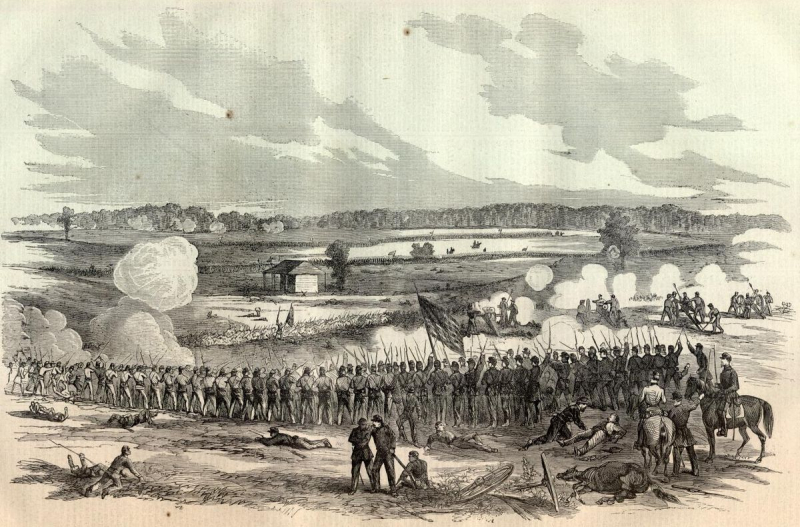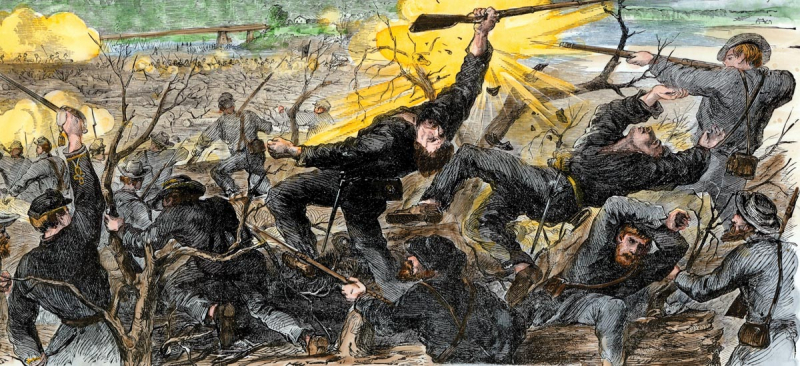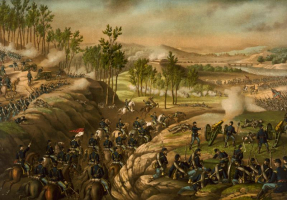Top 6 Facts About The Battle of Perryville
The Battle of Perryville, also known as the Battle of Chaplin Hills, was fought in the Chaplin Hills west of Perryville, Kentucky. The battle is seen as a ... read more...strategic Union success, frequently referred to as the Battle for Kentucky. For the rest of the war, the Union maintained control of Kentucky, a vital border state. Here are some interesting facts about the Battle of Perryville you should know.
-
One of the interesting facts about the Battle of Perryville is that Perryville was the largest battle fought in Kentucky. The Battle of Perryville, also known as the Battle of Chaplin Hills, took place on October 8, 1862, in the Chaplin Hills west of Perryville, Kentucky, as the finale of the American Civil War's Confederate Heartland Offensive (Kentucky Campaign). Confederate Gen. Braxton Bragg's Army of Mississippi originally gained a tactical win against a single corps of Union Army of Ohio Maj. Gen. Don Carlos Buell. Because Bragg fled to Tennessee soon after, the battle is seen as a strategic Union success, frequently referred to as the Battle for Kentucky. For the rest of the war, the Union maintained control of Kentucky, a vital border state.
During the Battle of Perryville, there were 72,196 combatants (55,396 Union and 16,800 Confederates). During the fight, 20,000 Union forces and 16,000 Confederates participated in the action. Because of these vast numbers, Perryville is the largest battle ever fought in Kentucky. It's worth noting that the forces present at Perryville represented 21 different states. Soldiers were from Alabama, Arkansas, Florida, Georgia, Illinois, Indiana, Kansas, Louisiana, Michigan, Minnesota, Missouri, Mississippi, North Carolina, New York, Ohio, Pennsylvania, Tennessee, Texas, Virginia, and Wisconsin.

wtvr.com 
en.wikipedia.org -
It is a fact that the Battle of Perryville has been called the Confederacy's "High Water mark". On October 8, 1862, Confederate forces under the command of General Braxton Bragg unintentionally engaged with Union troops under the command of General Don Carlos Buell, resulting in the greatest and bloodiest action of the war to take place on Kentucky land.
When the Federals were in a solid defensive position, with heavy artillery support and a stone wall at the top of a steep slope. Maney's and Stewart's men tried three unsuccessful attacks before withdrawing to the vicinity of the Open Knob around 5:30 p.m. The three-hour attack by Maney's brigade was the deadliest and, possibly, most critical action of the conflict. Maney's decisive defeat, according to historian Kenneth W. Noe, was the high-water mark of the Confederacy in the western theater, no less crucial than the Angle at Gettysburg.
The Battle of Perryville or Chaplin Hills has been termed the Confederacy's high watermark in the Western Theater of the war, but the Union Army's tactical success altered the tide of the Confederacy's fortunes in the West for the rest of the war. Not only did occasional fighting spill into Perryville's streets, but the battle's aftermath transformed the village's churches, residences, and other structures into temporary hospitals for wounded Blue and Gray soldiers.

wuky.org 
warfarehistorynetwork.com -
One of the interesting facts about the Battle of Perryville is that the Battle of Perryville was one of the bloodiest battles of the Civil War. During the Civil War, Kentucky was the location of 21 separate battles. This conflict is highly renowned for being one of the bloodiest battles of the Civil War and the most major battle fought in Kentucky. Major General Don Carlos Buell led the Union Army with the Army of Ohio, while General Braxton Bragg led the Confederacy with the Army of Mississippi. Confederate troops were advancing from Chattanooga, Tennessee, to Louisville, Kentucky. Union troops, on the other side, were on their way from Louisville when they were unexpectedly intercepted by the Confederate army. The Union troops outnumbered the Confederates by 22,000 to 16,000 in the battle.
Soldiers had to deal with a severe drought in Kentucky during the campaign. Because most water supplies were entirely depleted, the soldiers were forced to consume polluted water. As a result, they contracted dysentery, typhoid, and other ailments. When Buell's men converged on Bardstown, the Confederate troops, led by Bragg, withdrew to Perryville to take advantage of a safe water source and extensive road network. Despite the dry conditions caused by the drought, the Union soldiers continued their advance to Perryville. The Action of Perryville was not only the largest Civil War battle conducted in Kentucky, but it was also the bloodiest, with over 7,000 casualties and over 1400 deaths.

warfarehistorynetwork.com 
warfarehistorynetwork.com -
Another interesting fact about the battle is that a severe drought in the area led the two armies to Perryville. According to historian Ken Noe, the upper southwest of the Appalachians and the Midwest saw the worst drought in recorded history in the autumn of 1862. The drought was so severe that when Buell's Hoosiers arrived in Louisville, some of them just kept walking, across the Ohio River toward home. Both armies had marched north into Kentucky in desperate need of water, and as a result, the men were dehydrated and sick from the microorganisms they had consumed by drinking everything wet.
Buell's army, in pursuit of Bragg, converged in three columns on the little crossroads village of Perryville on October 7. Union forces clashed with Confederate cavalry on the Springfield Pike before the conflict spread to Peters Hill, where Confederate infantry arrived. Both parties were yearning for access to clean water. At dawn the next day, action resumed around Peters Hill as a Union division advanced up the pike, stopping just before the Confederate position. After noon, a Confederate division attacked the Union left flank, forcing Maj. Gen. Alexander M. McCook's I Corps to retreat. When more Confederate divisions joined the fight, the Union line held firm, counterattacked, and eventually fell back, with some regiments routed. Only two days after the battle, the drought abruptly ended when a cold front moved through the region, bringing rain and cool temperatures to Kentucky.

amnews.com 
lancasteratwar.com -
One of the interesting facts about the Battle of Perryville is that Simon Bolivar Buckner who fought at Perryville was the father of a major World War II general. Simon Bolivar Buckner was a Confederate warrior and politician from the United States. He served in the United States Army during the Mexican-American War and served in the Confederate States Army during the American Civil War. The Battle of Perryville began on October 8, 1862, when Bragg's army engaged Maj. Gen. Alexander McCook's corps of Buell's army. During this engagement, Buckner's division fought under General Hardee, making a significant breakthrough in the Confederate center, and reports from Hardee, Polk, and Bragg all lauded Buckner's actions. His valor was for naught, as Perryville resulted in a tactical draw that cost both forces dearly, forcing Bragg to withdraw and abort his invasion of Kentucky. Buckner joined several of his fellow generals in publicly criticizing Bragg's campaign performance.
Buckner's son, Lt. General Simon B. Buckner, Jr., in command of American land troops on Okinawa, was killed by Japanese artillery on June 18, 1945. Buckner was the highest-ranking American military officer killed by enemy fire during WWII. Buckner was raised to the rank of four-star general on July 19, 1954, by a Special Act of Congress (Public Law 83-508).

Simon Bolivar Buckner Sr -en.wikipedia.org 
Simon Bolivar Buckner Jr. -en.wikipedia.org -
Another interesting fact about the battle of Perryville is that on October 8, 1954, the Perryville State Battlefield Site was established. Perryville became the location of the state's most catastrophic Civil War combat, which killed, maimed, or went missing about 7,600 people. Perryville Battlefield State Historic Site is presently a 745-acre park in Boyle County, Kentucky, near Perryville. The park is being expanded with tracts purchased by the Kentucky Heritage Land Conservation Fund and the American Battlefield Trust from the Office of Kentucky Nature Preserves.
The Commonwealth of Kentucky has conserved portions of the Perryville battlefield. The Perryville Historic District, which encompasses downtown Perryville, also includes structures that played roles in the fight, such as the Elmwood home, which was pushed into service as a field hospital during the battle. The American Battlefield Trust, its members, and the Kentucky Heritage Land Conservation Fund of the Office of Kentucky Nature Preserves have conserved 1,202 acres in the Perryville Battlefield until late 2021.
A museum interprets the place where many Confederate troops killed in the Battle of Perryville are buried. In addition, monuments, interpretative plaques, and cannons commemorate significant events that occurred during the war. In 1936, the site was added to the Kentucky State Park System.

en.wikipedia.org 
en.wikipedia.org



























